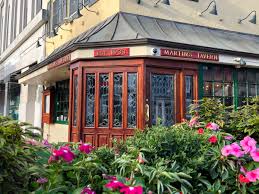Even with gourmet food or complex cocktails, a restaurant or bar is nothing without ambiance. Furniture, lighting, music, and color scheme are all important, but for an added twist, nothing beats location, especially one with a unique history. Here are three legendary establishments with unexpected origin stories that add to their character:
The Edison
Los Angeles’ First Downtown Power Plant Turned Gothic Bar
The Higgins Building in downtown Los Angeles, named after Irish-American immigrant Thomas Higgins, has had many lives over its 100-plus-year history. It has served as an office and retail space, a cultural focal point for LA’s vibrant 1920s music scene, a home to the Bureau of Engineering and General Petroleum, and even a rooftop cafe for the Women’s Progressive League.
Its basement, long neglected and submerged in eight feet of water, was once one of the city’s first electric generation stations. When Andrew Meieran bought The Higgins in 1998, he saw potential where others saw decay. By 2007, Meieran and a partner transformed the basement into The Edison, a swanky steampunk cocktail bar. They preserved the building’s history by illuminating the space with Edison-era lightbulbs and playing music from an Edison cylinder player. The result is a bar that not only serves drinks but also immerses patrons in a historical experience, making The Edison a bright idea born from the past.
Arlene’s Grocery
From Bodega to Iconic Music Venue
Before 1995, few would have predicted that a modest bodega and butcher shop in Manhattan’s Lower East Side would become a hotbed for the music world’s biggest acts. But after a strategic buyout and revamp, which cheekily retained only the name and exterior, Arlene’s Grocery emerged as a divey rock venue. Its transformation coincided with the neighborhood’s burgeoning nightlife scene.
Since its opening, Arlene’s Grocery has hosted performances by now-famous artists like Lady Gaga, Arcade Fire, Jeff Buckley, and The Strokes, who played there in 2000 before their rise to fame. Even today, the venue continues to support up-and-coming bands and artists, providing a stage seven nights a week. Despite the occasional confusion from hungry passersby, Arlene’s Grocery stands as a testament to the dynamic evolution of urban spaces and the power of music to redefine a locale.
Forbes Island
A Floating Home Turned Seaside Restaurant
In 1975, millionaire Forbes Kiddoo conceived the idea of Forbes Island, a 700-ton floating home, intended to be a private residence in Sausalito, just north of San Francisco. However, local residents’ complaints led to his eviction in 1991. Not deterred, Kiddoo sought approval to dock his creation in San Francisco proper, where he was granted a 15-year renewable lease.
Kiddoo transformed Forbes Island into a unique seaside restaurant, anchoring it at the tourist-centric Pier 39 for two decades. The floating island became a beloved landmark, offering diners an unusual and memorable experience. After a series of fires and renovations, Kiddoo retired in 2017, and the restaurant closed down.
Today, Forbes Island has found new life as an event center in the Sacramento River Delta under new ownership. Kiddoo’s journey from a personal floating residence to a commercial success story is a remarkable example of tenacity and the creative use of unconventional spaces.


